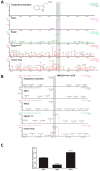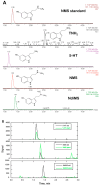On the Biosynthesis of Bioactive Tryptamines in Black Cohosh (Actaea racemosa L.)
- PMID: 39861645
- PMCID: PMC11768127
- DOI: 10.3390/plants14020292
On the Biosynthesis of Bioactive Tryptamines in Black Cohosh (Actaea racemosa L.)
Abstract
Botanical dietary supplements are widely used, but issues of authenticity, consistency, safety, and efficacy that complicate their poorly understood mechanism of action have prompted questions and concerns in the popular and scientific literature. Black cohosh (Actaea racemosa L., syn. Cimicifuga racemosa, Nutt., Ranunculaceae) is a multicomponent botanical therapeutic used as a popular remedy for menopause and dysmenorrhea and explored as a treatment in breast and prostate cancer. However, its use and safety are controversial. A. racemosa tissues contain the bioactive serotonin analog N-methylserotonin, which is thought to contribute to the serotonergic activities of black cohosh-containing preparations. A. racemosa has several TDC-like genes hypothesized to encode tryptophan decarboxylases (TDCs) converting L-tryptophan to tryptamine, a direct serotonin precursor in plants. Expression of black cohosh TDC1, TDC2, and TDC3 in Saccharomyces cerevisiae resulted in the production of tryptamine. TDC1 and TDC3 had approximately fourfold higher activity than TDC2, which was attributable to a variable Cys/Ser active site residue identified by site-directed mutagenesis. Co-expression in yeast of the high-activity black cohosh TDCs with the next enzyme in serotonin biosynthesis, tryptamine 5-hydroxylase (T5H), from rice (Oryza sativa) resulted in the production of serotonin, whereas co-expression with low-activity TDCs did not, suggesting that TDC activity is a rate-limiting step in serotonin biosynthesis. Two T5H-like sequences were identified in A. racemose, but their co-expression with the high-activity TDCs in yeast did not result in serotonin production. TDC expression was detected in several black cohosh tissues, and phytochemical analysis using LC-MS revealed several new tryptamines, including tryptamine and serotonin, along with N-methylserotonin and, interestingly, N-N-dimethyl-5-hydroxytryptamine (bufotenine), which may contribute to hepatotoxicity. Incubation of A. racemosa leaves with tryptamine and N-methyltryptamine resulted in increased concentrations of serotonin and N-methylserotonin, respectively, suggesting that methylation of tryptamine precedes hydroxylation in the biosynthesis of N-methylserotonin. This work indicates a significantly greater variety of serotonin derivatives in A. racemosa than previously reported. Moreover, the activities of the TDCs underscore their key role in the production of serotonergic compounds in A. racemosa. Finally, it is proposed that tryptamine is first methylated and then hydroxylated to form the black cohosh signature compound N-methylserotonin.
Keywords: Actaea racemosa; Cimicifuga racemosa; Rannunculaceae; black cohosh; secondary metabolism; serotonin; tryptamines; tryptophan decarboxylase.
Conflict of interest statement
The authors declare no conflicts of interest. The funders had no role in the design of the study; in the collection, analysis, or interpretation of data; in the writing of the manuscript; or in the decision to publish the results.
Figures








Similar articles
-
Metabolism of Nω -methylserotonin, a serotonergic constituent of black cohosh (Cimicifuga racemosa, L. (Nutt.)), by human liver microsomes.Biomed Chromatogr. 2014 Dec;28(12):1647-51. doi: 10.1002/bmc.3197. Epub 2014 May 12. Biomed Chromatogr. 2014. PMID: 24817649 Free PMC article.
-
Ethnobotany, Phytochemistry, Traditional and Modern Uses of Actaea racemosa L. (Black cohosh): A Review.Adv Exp Med Biol. 2021;1308:403-449. doi: 10.1007/978-3-030-64872-5_24. Adv Exp Med Biol. 2021. PMID: 33861455 Review.
-
Gene identification in black cohosh (Actaea racemosa L.): expressed sequence tag profiling and genetic screening yields candidate genes for production of bioactive secondary metabolites.Plant Cell Rep. 2011 Apr;30(4):613-29. doi: 10.1007/s00299-010-0979-5. Epub 2010 Dec 28. Plant Cell Rep. 2011. PMID: 21188383
-
In vitro serotonergic activity of black cohosh and identification of N(omega)-methylserotonin as a potential active constituent.J Agric Food Chem. 2008 Dec 24;56(24):11718-26. doi: 10.1021/jf803298z. J Agric Food Chem. 2008. PMID: 19049296 Free PMC article.
-
[Efficacy and safety of Black cohosh (Actaea/Cimicifuga racemosa) in the treatment of vasomotor symptoms--review of clinical trials].Ginekol Pol. 2008 Apr;79(4):287-96. Ginekol Pol. 2008. PMID: 18592868 Review. Polish.
Cited by
-
Integrating data augmentation and BERT-based deep learning for predicting alpha-glucosidase inhibitors derived from Black Cohosh.Sci Rep. 2025 Aug 27;15(1):31536. doi: 10.1038/s41598-025-14699-1. Sci Rep. 2025. PMID: 40866460 Free PMC article.
References
-
- Ma C., Kavalier A.R., Jiang B., Kennelly E.J. Metabolic profiling of Actaea species extracts using high performance liquid chromatography coupled with electrospray ionization time-of-flight mass spectrometry. J. Chromatogr. A. 2011;1218:1461–1476. doi: 10.1016/j.chroma.2011.01.033. - DOI - PMC - PubMed
-
- McCoy J.A., Davis J.M., Camper N.D., Khan I., Bharathi A. Influence of rhizome propagule size on yields and triterpene glycoside concentrations of black cohosh [Actaea racemosa L. syn Cimicifuga racemosa (L.) Nuttal] HortScience. 2007;42:61–64. doi: 10.21273/HORTSCI.42.1.61. - DOI
-
- Predny M.L., DeAngelis P., Chamberlain J.L. Black Cohosh: An Annotated Bibliography. Southern Research Station; Asheville, NC, USA: 2006. pp. 1–108.
-
- Small C.J., Chamberlain J.L., Mathews D.S. Recovery of black cohosh (Actaea racemosa L.) following experimental harvests. Am. Midl. Nat. 2011;166:339–348. doi: 10.1674/0003-0031-166.2.339. - DOI
-
- Castelo-Branco C., Gambacciani M., Cano A., Minkin M.J., Rachoń D., Ruan X., Beer A.M., Schnitker J., Henneicke-von Zepelin H.H., Pickartz S. Review & meta-analysis: Isopropanolic black cohosh extract iCR for menopausal symptoms—An update on the evidence. Climacteric. 2021;24:109–119. - PubMed
Grants and funding
LinkOut - more resources
Full Text Sources
Other Literature Sources
Miscellaneous

